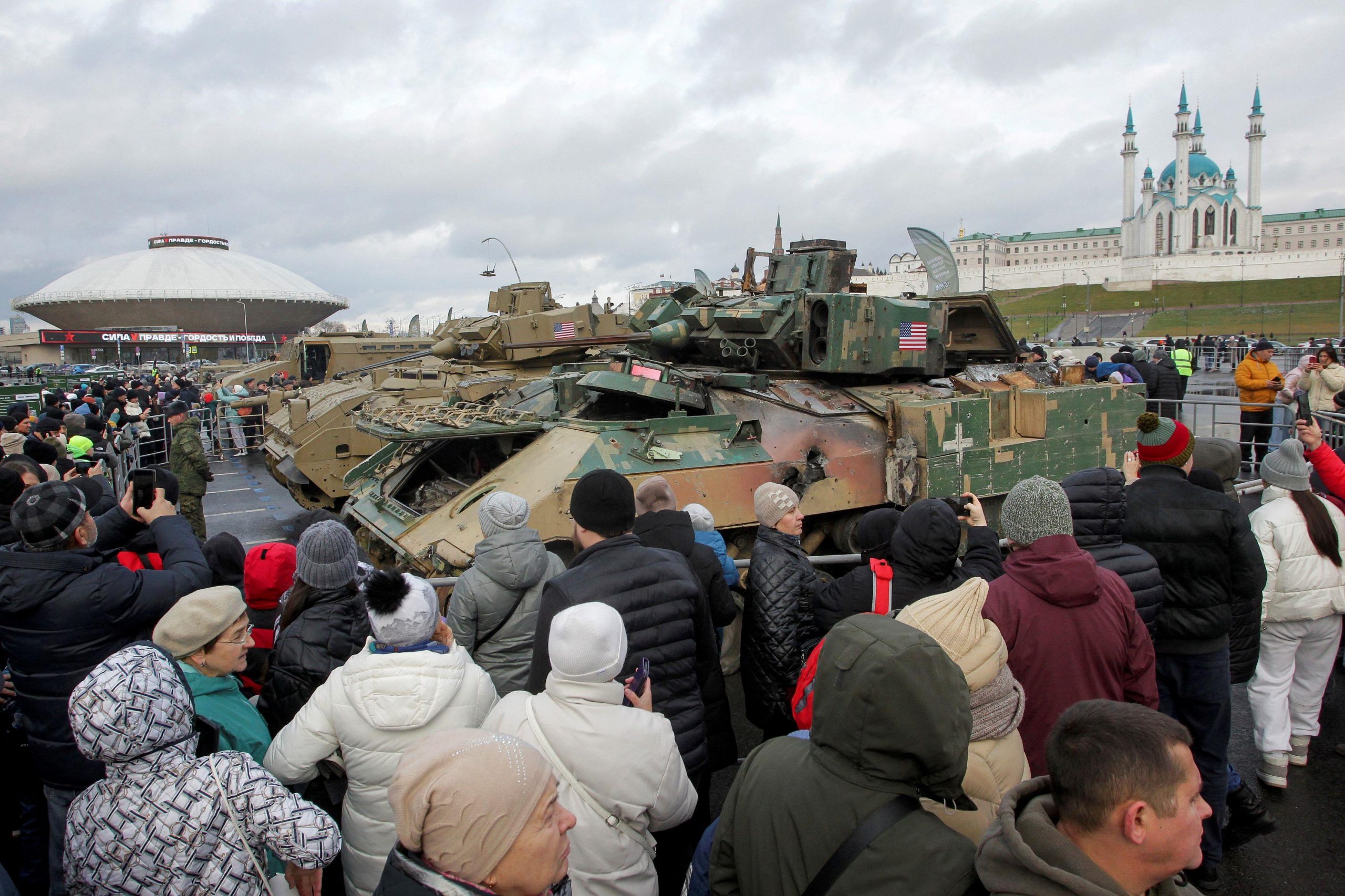KYIV, Ukraine—Killer robots have arrived on the Ukrainian battlefield.
In a front-line dugout this spring, a Ukrainian drone navigator selected a target—a Russian ammunition truck—by tapping it on a tablet screen with a stylus. The pilot flicked a switch on his handset to select autopilot and then watched the drone swoop down from a few hundred yards away and hit the vehicle.
“Let it burn,” said one of the team, as they observed a plume of smoke on a video feed from a reconnaissance drone.
Strikes like this represent a big advance in Ukraine’s attempts to use computers to help it combat Russia’s huge army. The drone that carried it out was controlled in the final attack phase by a small onboard computer designed by the U.S.-based company Auterion. Several other companies, many of them Ukrainian, have successfully tested similar autopilot systems on the battlefield.
Now, an even bigger breakthrough looms: mass-produced automated drones. In a significant step not previously reported, Ukraine’s drone suppliers are ramping up output of robot attack drones to an industrial scale, not just prototypes.
Enabling the upshift is producers’ successful integration of inexpensive computers into sophisticated, compact systems that replicate capabilities previously found only in far pricier equipment.
“None of this is new,” said Auterion founder and chief executive Lorenz Meier. “The difference is the price.”
Kyiv is set to receive tens of thousands of Auterion’s miniature computers, known as Skynode, which should hit the battlefield early next year. Vyriy Drone, a top Ukrainian drone startup, said it would produce several thousand autopilot drones starting this month. Other companies are also ramping up production.
Ukraine, with a population one-quarter the size of Russia’s, is reliant on maintaining a technological edge to hold off waves of Russian tanks and infantry. The use of computer-controlled drones is particularly promising as it significantly reduces the number of people needed to carry out tasks from identifying targets to striking them. They also offer a cheap alternative to more expensive missiles and artillery shells that could help Ukraine maintain its defense if the new Trump administration cuts funding.
Ukraine’s small explosive drones are already carrying out most of strikes on the front line. The large-scale production of autonomous drones could turbocharge Ukraine’s fight against Russia by overcoming the biggest obstacle those drones face: Russian electronic jamming.
“The tech has moved from concept to the battlefield, but the question is, will it exist in numbers to make an impact?” said Samuel Bendett, senior associate in the Europe, Russia and Eurasia program at the Center for Strategic and International Studies.
The advances also place further developments on the immediate horizon, such as enabling one pilot to control a swarm of several drones that can largely fly and coordinate themselves. Auterion’s technology is part of Ukrainian startup Swarmer’s efforts to implement drone swarms, while Vyriy is working with Sine Engineering, another new Ukrainian company.
Russia has also said it is using computer-guided drones to strike targets. In addition, several videos have appeared online claiming to show Russian explosive drones guided by long fiber-optic cables, avoiding jamming and providing a clearer video feed.
Ukraine’s nimble use and adaptation of aerial drones for reconnaissance and strikes has given it an edge over Russia since the start of the war. Ukraine has typically innovated faster than Russia, but the Kremlin’s advantage lies in its ability to increase production in its state-directed economy once it has equipment that works.
Kyiv’s drone makers are the antithesis of modern armament producers, which have become industrial behemoths. Ukraine’s young companies, operating under threat of attack and tapping innovation from all corners of society, have formed an industrial ecosystem of garage-sized factories and converted workshops. Coordinated with government help, many specialized in certain components, such as propellers, structural elements and motors.
With limited supplies of artillery ammunition , Ukraine has in the past year become increasingly reliant on explosive drones to hold back the Russian waves. The fast, nimble craft have four rotors and are about the size of a dinner plate. They are controlled by a pilot wearing goggles that receive a live video feed from an onboard camera. They are known as first-person-view drones, or FPVs, and have explosives attached that detonate on impact.
Russia has countered Ukrainian drones primarily by using electronic-warfare equipment that can down them by drowning out the signal between the controller and the craft. That means that, depending on the skill of the pilot, about one in five FPVs hit their targets, according to pilots.
Autopilot technology negates that countermeasure by integrating the control system into the drone via software loaded onto a cheap minicomputer.
Expensive missiles have used the technology, known as terminal guidance, since the 1970s. Companies including Auterion and Vyriy are making it small, cheap and smart—able even to track and hit moving targets.
Both companies’ solutions track a battlefield target using a technology called pixel-lock, where the drone latches onto its prey using its camera and computer, without needing to be remotely guided by an operator.
Vyriy aims for the lowest cost possible. It was founded after the Russian invasion in 2022 by 26-year-old Oleksiy Babenko, a motorbike fanatic who studied sociology.
His company developed software that allows a tiny, off-the-shelf computer costing around $15 to fly the drone toward a target, using a camera that costs about the same.
Babenko said the drones have a success rate of around nine out of 10 once autopilot is engaged but had recently encountered problems with Russian forces using electronic jamming to cut the analog video signal that the pilot uses to fly the craft to the strike zone.
Vyriy is seeking to overcome the issue by enabling the video feed to hop between frequencies, as well as by developing a digital video link. The company is seeking to keep the cost under $50.
“The best thing is that it’s very cheap,” said Babenko. “We can’t put some high price video link.”
Almost all components for the drone are produced in Ukraine. The motors and camera come from China, while the minicomputer comes from another country.
Babenko and his co-founders put up $20,000 to start the company and money has poured in from the government, military units and charity funds who buy their drones. Ukrainian charities that source equipment for their military have been a key partner as they don’t require much paperwork, meaning they can buy something, give it to soldiers to test and try something else if it doesn’t work, creating competition between drone companies.
“Now in Ukraine, if you produce something cool you don’t need a lot of money to make more,” Babenko said.
Virginia-based Auterion, which has supplied the Defense Department and other federal agencies with a variety of drones for several years, is part of Pentagon efforts to develop drones that can evade electronic jamming. For Ukraine, it only produces Skynode, a bespoke minicomputer the size of a small fist that already uses a digital video. The processor goes into drones built by Ukrainian companies.
Auterion differs from many other drone-technology suppliers because Skynode integrates a range of functions including guidance, targeting and networking, all using fully digital communications that complicate hacking or jamming. Meier, Auterion’s founder, compares it to how smartphones combined tasks previously handled separately by cellphones, digital cameras and satellite-navigation units. Because of its versatility, it has also been used on fixed-wing strike drones, which have a greater range, he said.
Skynode, which Meier said costs about as much as an Android smartphone, replaces the computer brain in almost any drone, he said. Meier is known in the drone world for having years ago created a variety of widely used open-source software.
Autopilot offers a string of advantages. In standard FPVs, the link between the controller and the drone relies on radio waves, so the drone needs to avoid large objects that can block the signal. Ukrainian drone teams often send up a second craft to hover in the air and relay the signal between pilot and FPV, allowing them to operate from a bunker and extend the range of the craft up to 15 miles. But the Russians hide tanks and other potential targets on the far side of hills or behind obstacles that cut the link as the drone approaches.
Using terminal guidance overcomes those issues. Autopilot mode can be engaged roughly two-thirds of a mile from a target—well outside the short range of jammers. Drones with autopilot can strike objects behind hills as they don’t need to maintain a signal with the pilot in the attack phase.
The onboard computer stabilizes the drone, meaning the pilot doesn’t have to constantly toggle the pitch and throttle to keep it steady. One pilot told Auterion that flying the drone and striking Russian targets was so easy that it was boring.



